Perspectives on Engineered Log Jams
By Amy Nelson
It is one thing to read a case study or watch a presentation about improving salmonid habitat by placing a massive, engineered log jam into a large, powerful river. It’s quite another to craft the design, interface with landowners and other stakeholders, keep the project on schedule and within budget, and make in-field adjustments. How many of us have tried to obtain permits for structures made of hundreds of multi-ton logs, many of which were to be delivered by helicopter? Few among us know what it’s like to work in a river that can flow up to 82,000 cubic feet-per-second, or to watch the excavator carve into a riverbed with highly variable subsurface conditions.

To get a true sense of the realities of reintroducing large wood to fluvial systems, we decided to chat with folks who actually do this type of work. Burke Strobel of the Portland Water Bureau, Marjorie Wolfe of Wolf Water Resources, Rocky Hrachovec of Natural Systems Design, and Matt Koozer of Biohabitats have each worked on several of these projects in the Pacific Northwest, a region well-known for its leadership in the use of wood for river restoration. They recently collaborated on a restoration project involving large wood along the salmonid bearing, Wild and Scenic Sandy River in Oxbow Regional Park, a 1,000-acre park located a half-hour east of Portland and managed by the region’s Metro Parks Department. Sandy River Basin Partners, a group of several land use stewards in the watershed (including the Portland Water Bureau, Metro, the Bureau of Land Management, and The Nature Conservancy), have been doing restoration work in the Sandy for several years.
The goal of the restoration, a project for the Portland Water Bureau, was to create much-needed off-channel winter habitat for threatened fish, primarily Coho, Chinook, and steelhead. The overall river restoration design, led by Wolf Water Resources, involved reconnecting a 2,200-foot side channel and installing two 600-piece engineered log jams to engage the side channel when mainstem flows exceed 800 cfs. The engineered log jams were designed by Natural Systems Design and installed by Biohabitats during the summers of 2017 and 2018. This massive undertaking also included some unexpected surprises, like a wildfire that broke out near the project site during the first season of construction. We asked these seasoned practitioners to share their thoughts and stories about the risks and rewards of this leading-edge restoration technique.
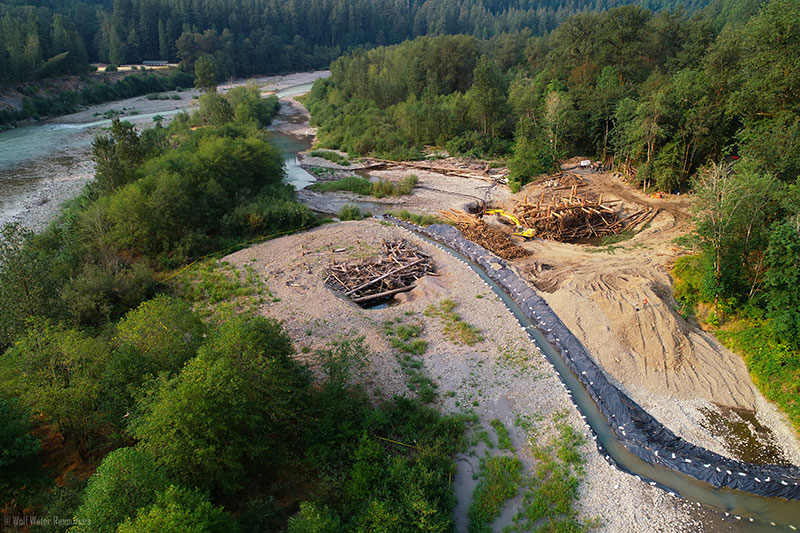
What did you find most challenging about your work at Oxbow Park on the Sandy River?
Burke: We were working in a river that is highly changeable. The banks are made of a very fine substrate, so erosion happens naturally. The real challenge was to coax the river to do what it wants to do and still end up meeting our design goals.
Marjorie: The rigid requirements of the mitigation—having to engage the side channel at a specific flow rate rather than something that might be more natural to the river. Those requirements were driven by a habitat conservation plan that was crafted to meet certain biological criteria. Ensuring that these criteria were met in a way that did not unreasonably constrain the river was challenging.
Matt: For us, the greatest challenges were working in a river that large, having to achieve the scour depth by digging a hole 20 feet below the bed of a river in an active channel, and accessing the site—getting from the top of the canyon to the bottom where the work occurred.
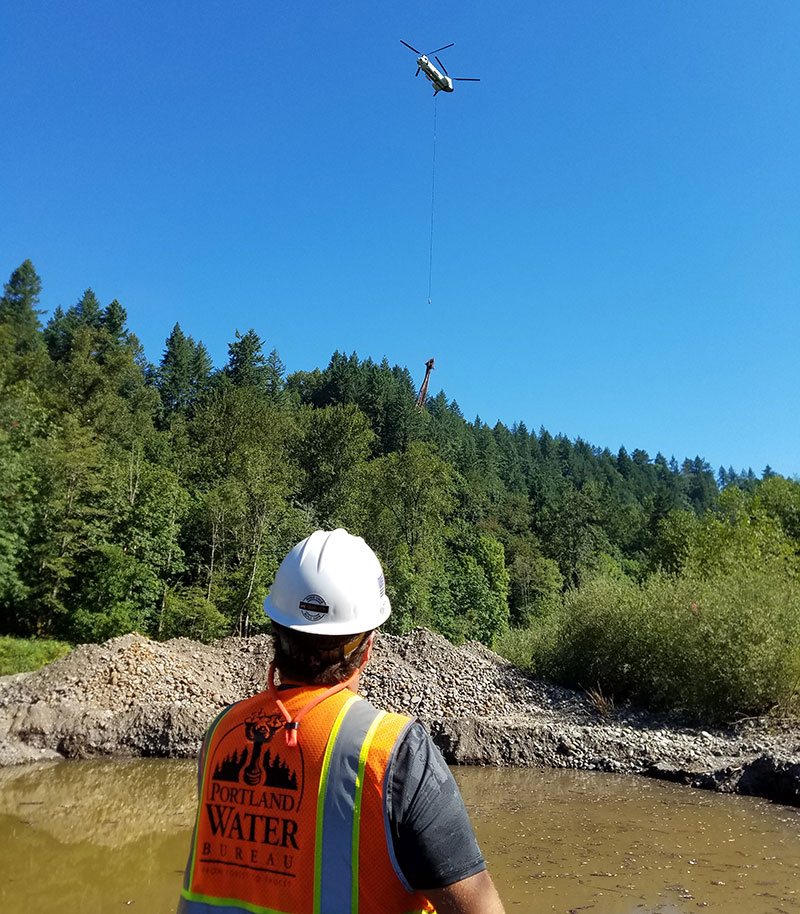
Rocky: A lot of challenges combined to make this a very difficult project. First: the very large size of the river. It had a peak flow of over 82,000 cfs. It is a very serious river with a lot of force and a lot of scour. Second: the complex setting. It’s a very dynamic section of the river with very fine sediment. Third: the site was very hard to get to. Coming up with a structure that is intended to be stable and meet hard, fixed mitigation goals in a setting that is extremely dynamic and unstable was also a tough challenge.
What was your strategy to create a design with the greatest likelihood of achieving that goal?
Rocky: In most settings, our standard method is to use piles, because we can drive them below scour depth. This site was so remote, we could not do that. Instead, we came up with a new approach that uses ground-based equipment. That approach allows for the use of common equipment, for the jam to settle into the river bed if it needs to, and for the structure to be slowly and incrementally put in place. It led to a structure that is quite large and can withstand the forces that are put upon it.
Water was reintroduced to the site in late August of 2018. At this point, do you consider the project to be a success?
Burke: I would definitely consider it a success. You go out there and there is habitat that simply wasn’t there before. Creating new habitat is one of the biggest benefits you can give to fish populations.
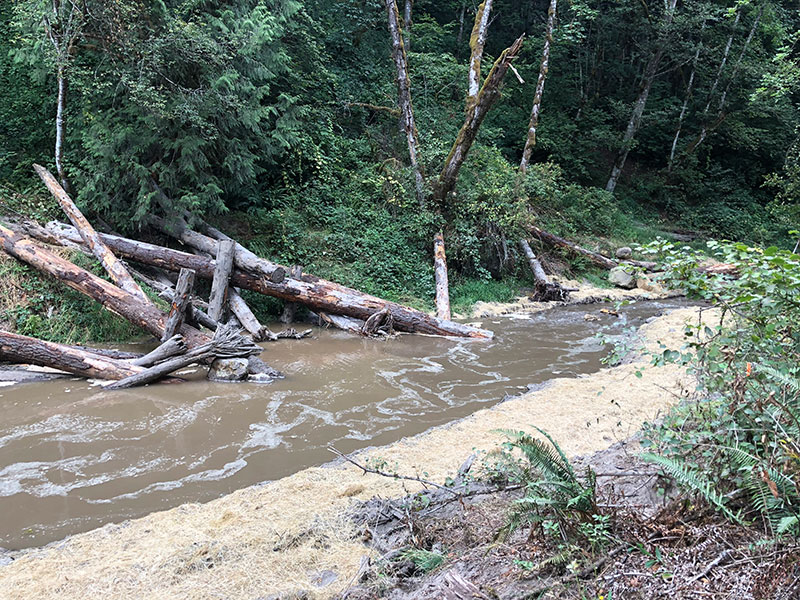
Marjorie: I absolutely think it’s a success. There is a good balance between meeting the mitigation requirements but also allowing the site to adapt and change over time. There is a lot more flow in the side channel than we had anticipated, but that additional flow has improved the chances of success for both the mitigation requirements and long-term evolution of the site.
Rocky: It was built well in very challenging situations. There was a lot of water that needed to be diverted. There were tough site constraints, such as on-site groundwater and limited work hours because of fire closures during the first construction season. Some material was hauled in and some was flown in, and there were a lot of logistics involved in handling, staging, managing, delivering, and installing that material. It’s a great, big cake that takes a lot of ingredients and a lot of mixing. When you complete one of these, there is success right out of the gun just having gotten it done. But more importantly, the purpose of the project was to reawaken a dormant side channel and provide rearing habitat for coho, and we are seeing that on the landscape. I do consider this project a success, and I look forward to watching it continue to grow and morph. My hope is that the habitat value of this area will continue to grow over time. [Unlike most construction projects] this type of project should get better with age. With more flows, more natural processes will emerge on the landscape. It will create the complexity that lies at the heart of salmon habitat.
With such a great, big cake with a lot of ingredients, there could easily be too many cooks in the kitchen, but it sounds like this project involved a well-coordinated team. What do you think is the key to a successful client/designer/contractor relationship when you are trying to reintroduce large wood into a river system?
Burke: Constant communication was one of the biggest keys to success, and that communication goes in all directions. Early on, the design team listened to our goals and gave input that changed the direction of the project to something that had a higher likelihood of success. Communicating concerns and making it clear that you’ve heard other people’s concerns enables you to move on to solutions.
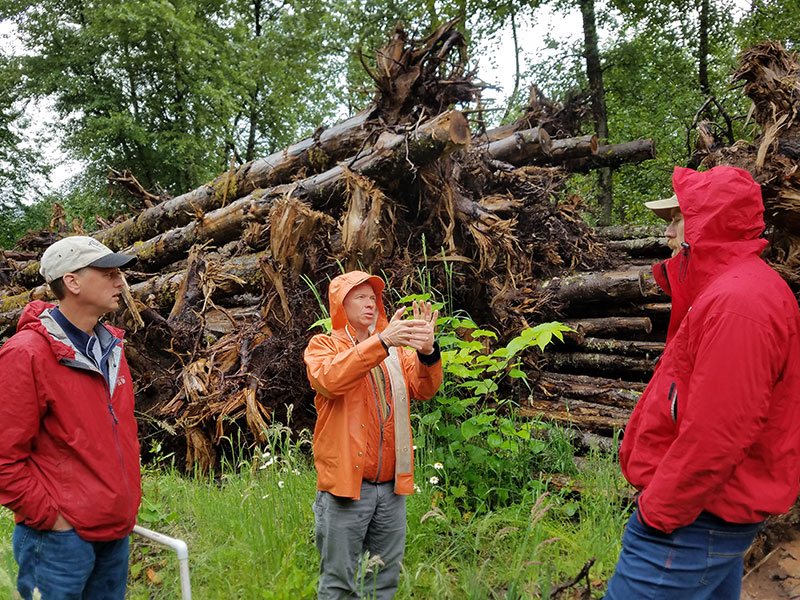
Marjorie: Burke is an incredible client. He is very knowledgeable about the habitat and the river. He monitors the river regularly and understands how it changes, so he really worked with us to make sure we were meeting the mitigation requirements while allowing for change and diversity. Rocky and I are both on the collaborative side of consulting. We are more interested in advancing the state of the science, sharing work products and approaches, and learning from each other than being competitive and wanting to maintain ownership of our own design. Having a real respect for the contractor is also key. It isn’t just the engineering that makes these things work. We rely on knowledgeable contractors who know how to implement the design and, in some cases, find better solutions to things like water management.
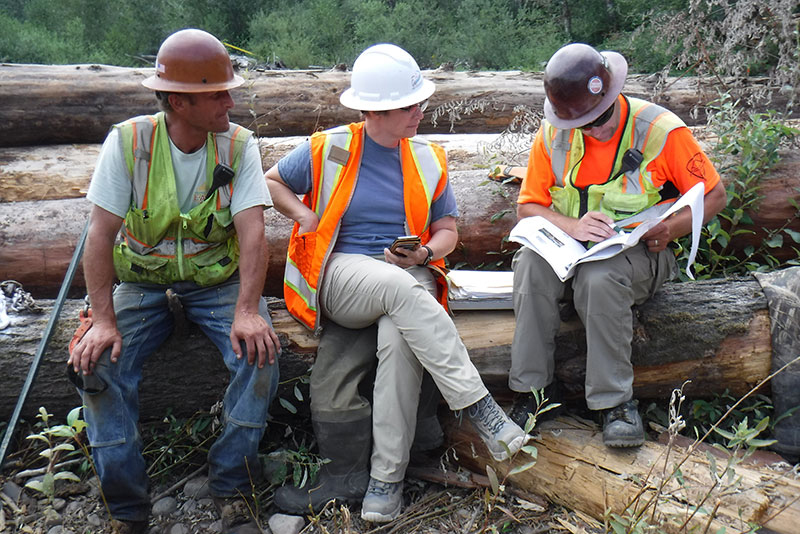
Rocky: You need a great design, a contractor who is willing to be flexible and innovative with implementation, and a client who understands the complexities of these projects and knows how to facilitate all of the operational elements to get it in the ground. The Portland Water Bureau really had an open mind, and understood that on a big river, you need to do big things. You don’t nibble around the edges. Ongoing collaboration and conversation are also essential for a project like this to be successful. The need for this project was set by Portland Water Bureau’s mitigation goals, but it could only be done in collaboration with the Metro Parks Department. The Water Bureau served as an advocate for the project on the scale required to meet their mitigation goal. Wolf Water Resources provided invaluable support all the way through this project, and Biohabitats came forth with thoughtfulness about how to stage and implement each segment of the project. We began the project with all of us in the room identifying the risks and talking about how to manage those risks. We continued that open dialogue all the way throughout the project to stay ahead of problems and logistical challenges.
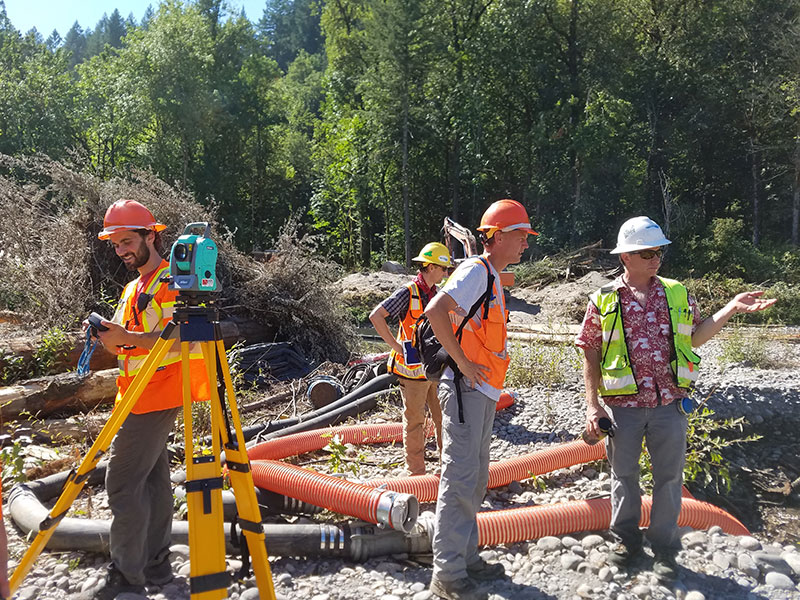
Matt: Communication and flexibility on everybody’s part was key. For example, early on, we identified that we were going to need more space on site to stage the cobble that we dug out of the pit. Burke did an awesome job working with the regulatory agencies to get us more space.
Burke, you are a fish biologist, and I understand you’ve been monitoring fish populations in the Sandy River. Have you snorkeled around the log jam at Oxbow Park?
Burke: I haven’t snorkeled there yet, but I will this summer. At another area of this restoration project, where we introduced flow into a floodplain tributary in 2017 with a similar goal of creating winter fish habitat, we saw juvenile coho in the channel shortly after we finished. Responses to these projects can happen on different scales. When you put in a wood structure, the first thing you see is fish from right next-door moving in. If they’re in a riffle 50 feet away, and they suddenly have a wood structure, they’ll just shift over to the wood. On a longer term, you see movement of juveniles into side channels and off-channel habitat getting ready for winter. The longer-term thing you’re really trying to affect is population dynamics. You want to see the numbers of fish increase over time.
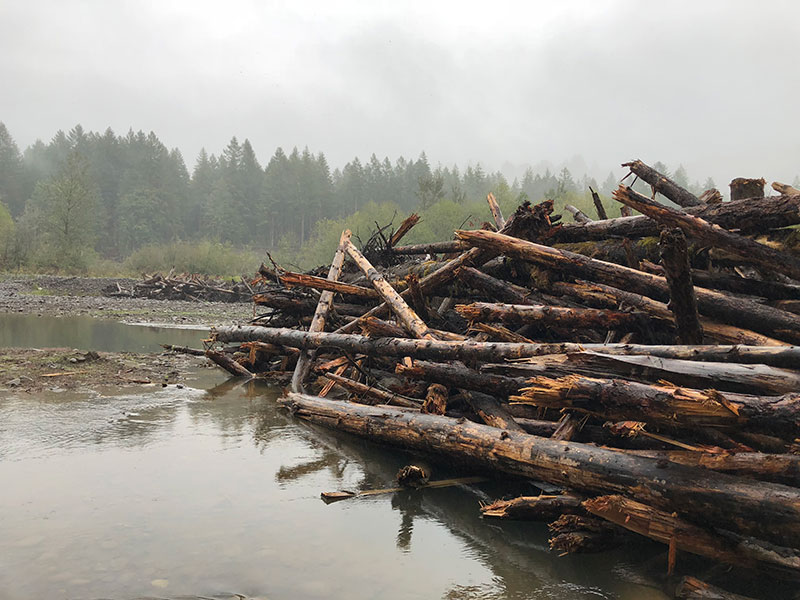
We are monitoring the Sandy River on a river scale, but it will probably take several years before we see changes we can attribute to the Oxbow project or any of the projects going on in the basin. We did baseline collection of habitat data in 2015, and we will do a lot of post-project monitoring over the course of the next 13 years. Fish monitoring is done by a variety of groups via smolt trapping in various tributaries. We’ve been doing that in a coordinated fashion in the basin since 2009.
There seems to be a lot of risk involved in this type of work. What element of risk kept you up at night, and how did you manage that risk?
Matt: Before we set up our diversion and dewatering system, we had a great plan figured out on paper, but we did not really know if it was going to work. We did not know what level of adjustments, adaptations, and maintenance our multi-tiered system would require in order to isolate the work area for the duration of the project. We were also concerned about how the timing of the diurnal daily snow melt runoff from Mount Hood would impact our system. We had to be prepared to make daily, if not hourly adjustments.
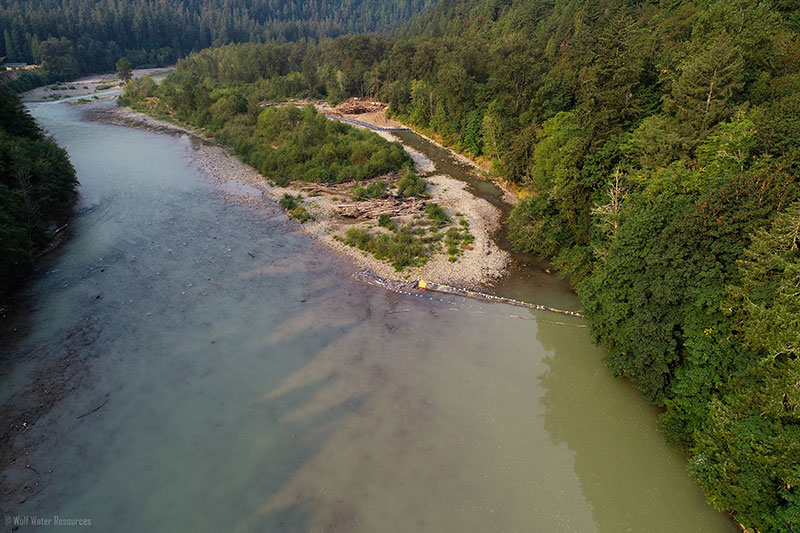
Rocky: There is an intrinsic level of stress with any large project, but the element that continued to nag at me with this one was the schedule. It was a big project, it got started later than we wanted, and then we had a fire. We couldn’t start too early in the morning because of the noise restrictions, and we had to be out by 1 pm because of the fire restrictions, so I was very worried about how we were going to get it done in one season. But public safety and respect for landowners is paramount. Fortunately, Burke negotiated with Portland Metro to allow us to go a second season. We also had no geotechnical data on this site, and we knew that the subsurface conditions were highly variable. There’s always a little anxiety when you’re putting down that first post at the deepest depth. You’re on the edge of your seat, waiting to see what the excavator brings up from the bottom of the hole.
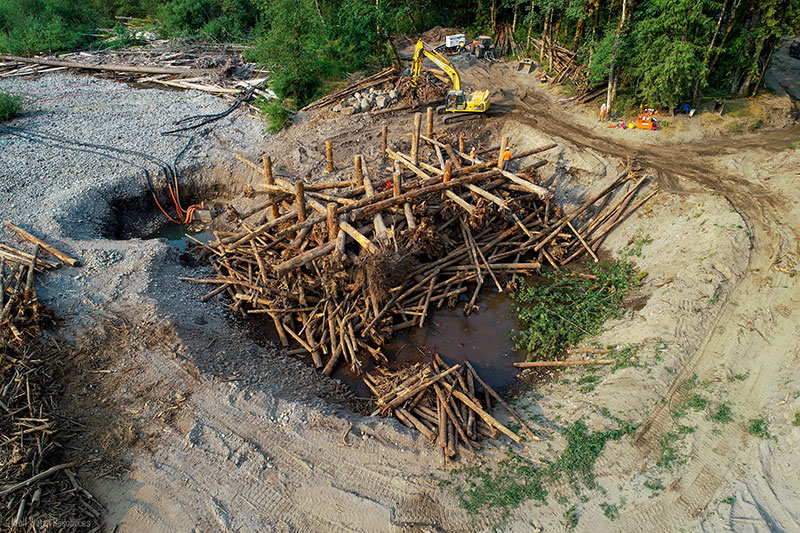
Marjorie: Engineered log jams are not designed to be playgrounds, but people will be people and they may climb on them. In the case of Oxbow, Metro does a great job of communicating the risks of that river to the public. They have signs everywhere. We cannot make a river like that safe for people; it would destroy the river. Along with Metro and Portland Water Bureau, we recognize that there are inherent risks in interacting with a river like that regardless of us ever being there.
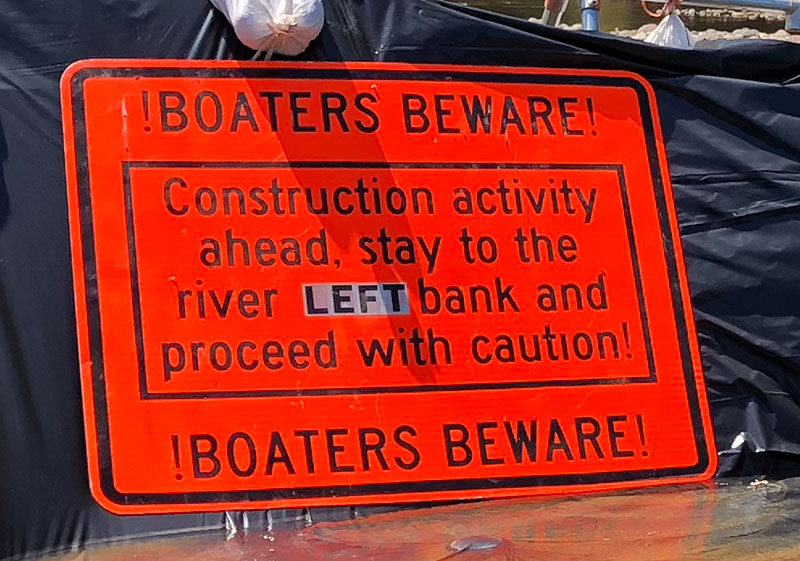
Burke: We needed to be confident that the project wouldn’t endanger adjacent uses or downstream infrastructure. There was a park downstream and across the river from our project, and there are bridges downstream. We had to take those into account and that’s what we did. It comes down to good, careful engineering and a thorough modeling with the best tools available to increase that confidence. Risk all comes down to confidence in how your structure and the environment are going to behave. Anything you can do to increase that confidence and consider all of the possible ways things could go wrong, is the way to deal with that
Mistakes and missteps do happen, though. And sometimes those mistakes present very powerful learning opportunities. Have there been any mistakes you’ve made or observed in the use of large wood that has really improved your work?
Burke: I have seen other projects that were not properly ballasted. They were ballasted for the summer, but not for particularly large floods in winter. If you see how projects fail, by being overtopped and having the upper layer stripped off and the integrity of the structure falls apart bit by bit, you learn something from that, and you apply it. The Oxbow project definitely benefitted from things that have been observed in other projects.
Matt: I think the biggest mistake people tend to make is underestimating the power of the river.
Rocky: I agree with Matt. We tend to underappreciate the power and persistence of flowing water. I have seen log structures wash away, on other designers’ sites…and on a few of my own. It is humbling to stand on the bank of a river and look at a blank space where a structure used to be. Size matters. There’s no getting around that. To make restoration happen, we need to work at scale and meet the river where it is. We have to listen to what the river is telling us about the size and magnitude of these structures. We also need to avoid hubris and recognize the uncertainty that lies within each project.
Most people working in ecological restoration are familiar with the concept of making field adjustments. But the systems in which you are working are so large and powerful. Can you share any stories or observations about adjusting in the field—on the Oxbow project or a project of similar scale?
Marjorie: There was no way of knowing how much water would come into holes that deep. We expected it all to come from the river, but it was coming from the hillside. We couldn’t have known that until we had a hole 30 feet deep. Biohabitats was very proactive in both fish salvage and water management. They floated their approach with the Oregon Fish and Wildlife biologist ahead of construction, and in doing that, invited his ideas for managing water in a way that would protect fish and other aquatic species during construction. That made construction much more manageable than it would have been if they had gone with the original idea of pumping the water.
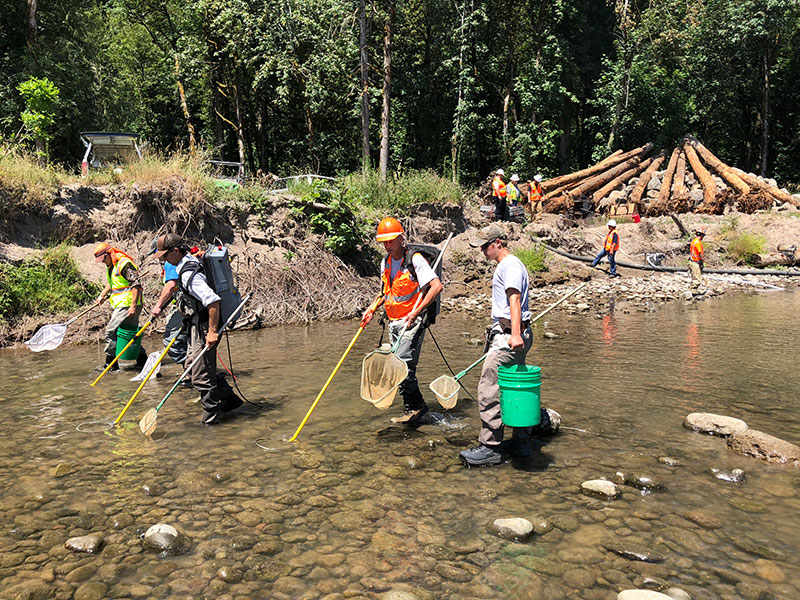
Rocky: I think about the way we were able to take advantage of large wood that happened to be available on site at Oxbow. There were trees that washed in and trees that had to be cleared, and those pieces of wood, which were bigger than anything we could have hauled or flown in, were just for our structure. Local materials are often bigger and in better condition, so we always look for ways to harvest and use them.
Burke: In 2017, we were building an engineered log jam on an island in the Sandy River. The place that the log jam had been designed to be was based on LiDAR coverage from years past, and things change in the river, and the location ended up being closer to the bank than what we originally intended. One of the slopes of the excavation pit, which went up against the riparian zone, ended up being much steeper than people were comfortable working around. Through rapid coordination, we were able to quickly stop work and consult with Rocky’s team. They evaluated the modeling they had done and came back to us within the same day with the instruction that we could shift the entire project 15 feet over into a safer working environment and the project would still function as designed. Hardly breaking stride, we were able to make that very substantial field adjustment without any real down side.
Matt: That reflects the kind of communication system we had set in place between Natural Systems Design, Wolf Water Resources, the Water Bureau, and Metro. Everybody knew how urgent it would be to make decisions quickly if we needed to make a change. We couldn’t afford to lose two days trying to figure things out. At Oxbow, by the time we got to the top few layers of the second log jam, we had already put in thousands of logs, and the pile of logs we had been pulling from for two years was down to the nitty gritty. Some were bent, and some were shorter or more rotted than we expected. But Rocky put his thinking cap on and really made it work with the remnants of the boneyard.
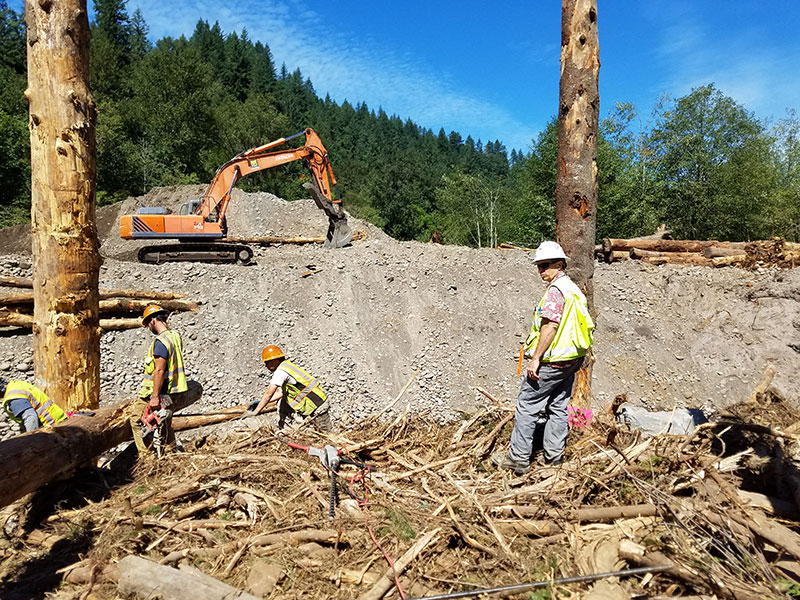
I understand that public perception can be quite a barrier to these types of projects. What strategies have you found to be effective in addressing public concerns (real or unfounded) about reintroducing large wood to rivers?
Burke: We definitely had to interact with the public and deal with potentially negative perceptions. Our approach was: be up front with landowners, boating groups, and other river users, and really spell out how we were planning to address concerns such as damage to infrastructure. Explaining design considerations can get pretty technical, but I think for some people it was comforting. For example, it was good for boaters to hear that the design considered the fact that boaters are on the river at potentially higher flows, so we didn’t want something in an area that would put them at greater risk.
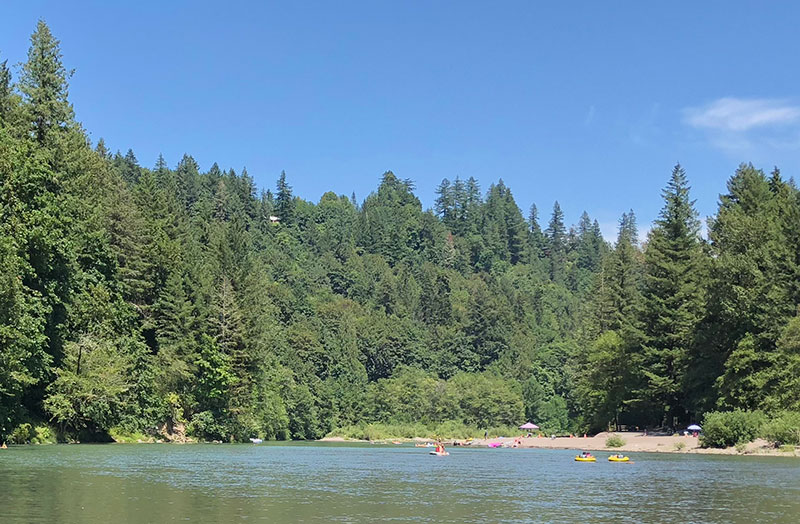
Marjorie: When working with wood in large rivers, we communicate risk at every level, including the risk of overhardening these structures and forcing a river into a fixed form. As a result, we don’t run into too much of that because our projects are typically much more about the stream process and dynamic change.
What advice do you have for practitioners in achieving the balance between the need for mobility and stability in reintroducing wood to large river systems.
Marjorie: It’s all about communicating risk. Often the need for stability is driven more by permit requirements than by any river design or habitat criteria. We need those permit requirements that say, “this log jam will withstand a 100-year flood event,” because hydraulically, we can do those calculations. We can also say that the wood structures can last, say, 25 years. But one of the pieces people are not necessarily thinking about is, when the 25 years are up, or when the river just shifts laterally in a big way and there are debris flows, rather than just storm flows, how does the project fail? How does it come apart? Is it going to rip up vital infrastructure and take it downstream, or is it going to come apart a piece at a time and those pieces become an active, engaged part of a river system as opposed to trash?
How can practitioners make sure that there will continue to be sources of wood in the river? How do you tie riparian restoration into this work?
Marjorie: Protecting riparian vegetation along stream banks is critical. So is floodplain reconnection. For decades, we’ve been so focused on in-channel work, and that is not where the greatest ecosystem value is. When the river is connected with the floodplain, it will pick up more of that wood, and support the creation of large wood by providing higher ground water and water to the floodplain so the trees can grow.
Any final thoughts?
Marjorie: Focus more of the restoration on the floodplain area, not just the channel or one species. If we are going to have any chance of saving the orca population, for example, we’ve got to do a lot more, we have to go bigger, and be serious about protecting floodplain and wetland resources.
Rocky: I really enjoyed working with Burke, Matt, and Marjorie. This was a really fun team that got great work done together.
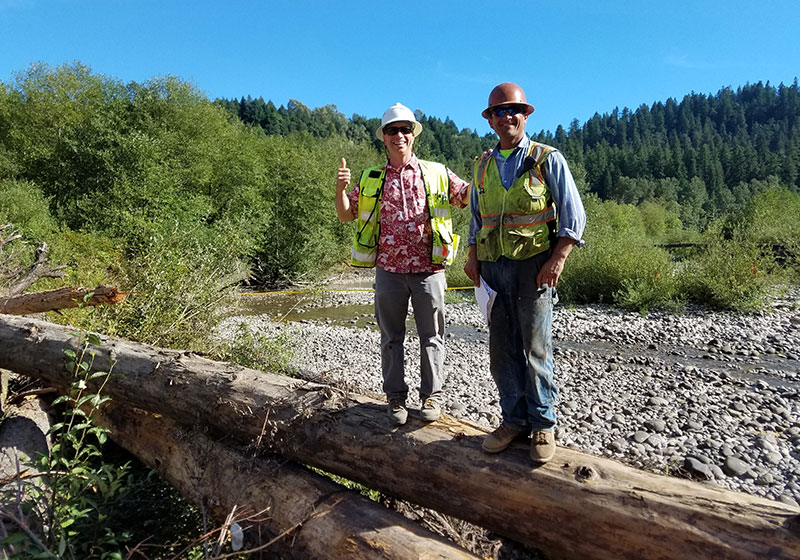
Thanks to these experts for sharing their insight:
Burke Strobel, Fish Biologist, Portland Water Bureau
Burke Strobel has been monitoring salmon and steelhead populations and habitat and conducting habitat restoration in the Pacific Northwest for over 25 years. He has previously worked for the US Forest Service and in the private sector.
Marjorie Wolfe, PE, CFM, Water Resources Engineer and President, Wolf Water Resources
Following decades of restoring habitat in the rivers and floodplains of Oregon, Washington, and Montana, and having worked for both consultant firms and public agencies, Marjorie Wolfe founded W2r in 2014 to address gaps in the way restoration work was being done. Specifically, she wished to work more closely with nature by learning from each project and restoring an ecosystem’s ability to self-heal, rather than imposing engineered constraints on dynamic systems.
Rocky Hrachovec, PE, Principal Engineer, Natural Systems Design
Rocky Hrachovec specializes in the design and construction supervision of river, stream and wetland restoration projects. In the past 15 years, Rocky has designed and managed projects involving the placement of thousands of logs in over 30 miles of restored streams and rivers. In these projects, he has used wood in rural and urban areas for habitat enhancement, channel stabilization and improved fish passage.
Matt Koozer, CPESC, Senior Restoration Ecologist and Construction Manager, Biohabitats
Matt Koozer has been leading interdisciplinary design-build teams in water resources management and habitat restoration efforts in the Pacific Northwest and Montana for more than 20 years. He has managed all phases of river, estuary, wetland and riparian restoration and management projects. Matt has focused the bulk of his career on habitat restoration design and construction.
